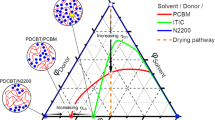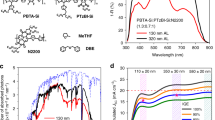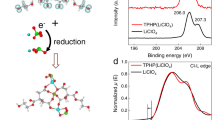Abstract
Polymer solar cells have drawn a great deal of attention due to the attractiveness of their use in renewable energy sources that are potentially lightweight and low in cost. Recently, numerous significant research efforts have resulted in polymer solar cells with power conversion efficiencies in excess of 9% (ref. 1). Nevertheless, further improvements in performance are sought for commercial applications. Here, we report polymer solar cells with a power conversion efficiency of 10.02% that employ a non-conjugated small-molecule electrolyte as an interlayer. The material offers good contact for photogenerated charge carrier collection and allows optimum photon harvesting in the device. Furthermore, the enhanced performance is attributed to improved electron mobility, enhanced active-layer absorption and properly active-layer microstructures with optimal horizontal phase separation and vertical phase gradation. Our discovery opens a new avenue for single-junction devices by fully exploiting the potential of various material systems with efficiency over 10%.
This is a preview of subscription content, access via your institution
Access options
Subscribe to this journal
Receive 12 print issues and online access
$209.00 per year
only $17.42 per issue
Buy this article
- Purchase on Springer Link
- Instant access to full article PDF
Prices may be subject to local taxes which are calculated during checkout




Similar content being viewed by others
References
Qian, M. et al. Dramatic enhancement of power conversion efficiency in polymer solar cells by conjugating very low ration of triplet iridium complexes to PTB7. Adv. Mater. 27, 3546–3552 (2015).
Jun, G. H. et al. Enhanced conduction and charge-selectivity by N-doped graphene flakes in the active layer of bulk-heterojunction organic solar cells. Energy Environ. Sci. 6, 3000–3006 (2013).
Chen, H. Y. et al. Polymer solar cells with enhanced open-circuit voltage and efficiency. Nature Photon. 3, 649–653 (2009).
Guo, X. G. et al. Polymer solar cells with enhanced fill factors. Nature Photon. 7, 825–833 (2013).
Duan, C. H., Zhang, K., Zhong, C. M., Huang, F. & Cao, Y. Recent advances in water/alcohol-soluble π-conjugated materials: new materials and growing applications in solar cells. Chem. Soc. Rev. 42, 9071–9104 (2013).
Chen, J. D. et al. Single-junction polymer solar cells exceeding 10% power conversion efficiency. Adv. Mater. 27, 1035–1041 (2015).
Liao, S. H., Jhuo, H. J., Chen, Y. S. & Chen, S. A. Fullerene derivative-doped zinc oxide nanofilm as the cathode of inverted polymer solar cells with low-bandgap polymer (PTB7-Th) for high performance. Adv. Mater. 25, 4766–4771 (2013).
Liu, S. J. et al. High-efficiency polymer solar cells via the incorporation of an amino-functionalized conjugated metallopolymer as a cathode interlayer. J. Am. Chem. Soc. 135, 15326–15329 (2013).
Qian, D. P. et al. Molecular design toward efficient polymer solar cells with high polymer content. J. Am. Chem. Soc. 135, 8464–8467 (2013).
Johnson, K. et al. Control of intrachain charge transfer in model systems for block copolymer photovoltaic materials. J. Am. Chem. Soc. 135, 5074–5083 (2013).
Gunes, S., Neugebauer, H. & Sariciftci, N. S. Conjugated polymer-based organic solar cells. Chem. Rev. 107, 1324–1338 (2007).
Liu, Y. H. et al. Aggregation and morphology control enables multiple cases of high-efficiency polymer solar cells. Nature Commun. 5, 5293–5300 (2014).
He, Z. C. et al. Single-junction polymer solar cells with high efficiency and photovoltage. Nature Photon. 9, 174–179 (2015).
Li, K. et al. Development of large band-gap conjugated copolymers for efficient regular single and tandem organic solar cells. J. Am. Chem. Soc. 135, 13549–13557 (2013).
Yang, Y. et al. An efficient trip-junction polymer solar cell having a power conversion efficiency exceeding 11%. Adv. Mater. 26, 5670–5677 (2014).
Ameri, T., Li, N. & Brebec, C. J. Highly efficient organic tandem solar cells: a follow up review. Energy Environ. Sci. 6, 2390–2413 (2013).
Lin, C. H. et al. Enhanced charge separation by sieve-layer mediation in high-efficiency inorganic–organic solar cells. Adv. Mater. 21, 759–763 (2009).
Xiao, T. et al. Inverted polymer solar cells with a solution-processed cesium halide interlayer. Org. Electron. 14, 267–272 (2013).
Williams, G., Wang, Q. & Aziz, H. The photo-stability of polymer solar cells: contact photo- degradation and the benefits of interfacial layers. Adv. Funct. Mater. 23, 2239–2247 (2013).
Graetzel, M., Janssen, R. A. J., Mitzi, D. B. & Sargent, E. H. Materials interface engineering for solution-processed photovoltaics. Nature 488, 304–312 (2012).
Henson, Z. B., Zhang, Y., Nguyen, T.-Q., Seo, J. H. & Bazan, G. C. Synthesis and properties of two cationic narrow band gap conjugated polyelectrolytes. J. Am. Chem. Soc. 135, 4163–4166 (2013).
Wang, V. B. et al. Improving charge collection in Escherichia coli–carbon electrode devices with conjugated oligoelectrolytes. Phys. Chem. Chem. Phys. 15, 5867–5872 (2013).
Kumar, A. et al. Donor–acceptor interface modification by zwitterionic conjugated polyelectrolytes in polymer photovoltaics. Energy Environ. Sci. 6, 1589–1596 (2013).
Duan, C. H. et al. Conjugated zwitterionic polyelectrolyte-based interface modification materials for high performance polymer optoelectronic devices. Chem. Sci. 4, 1298–1307 (2013).
Min, C. et al. A small-molecule zwitterionic electrolyte without a π-delocalized unit as a charge-injection layer for high-performance PLEDs. Angew. Chem. Int. Ed. 52, 3417–3420 (2013).
He, Z. C. et al. Enhanced power-conversion efficiency in polymer solar cells using an inverted device structure. Nature Photon. 6, 591–595 (2012).
Zhang, K. et al. Highly efficient inverted polymer solar cells based on a crosslinkable water-/alcohol-soluble conjugated polymer interlayer. ACS Appl. Mater. Interfaces 6, 10429–10435 (2014).
Griffini, G. et al. Long-term thermal stability of high-efficiency polymer solar cells based on photocrosslinkable donor–acceptor conjugated polymers. Adv. Mater. 23, 1660–1664 (2011).
Frederik, C. K. & Spanggaard, H. Significant improvement of polymer solar cell stability. Chem. Mater. 17, 5235–5237 (2005).
Kiy, M. et al. Observation of the Mott–Gurney law in tris(8-hydroxyquinoline) aluminum films. Appl. Phys. Lett. 80, 1198–1200 (2002).
Acknowledgements
This work was supported financially by the National Natural Science Foundation of China (51273209, 5141140244), Ningbo International Cooperation Foundation (2012D10009, 2013D10013), Ningbo Natural Science Foundation (2014A610126), the Open Fund of the State Key Laboratory of Luminescent Materials and Devices and the External Cooperation Program of the Chinese Academy of Sciences (no. GJHZ1219).
Author information
Authors and Affiliations
Contributions
X.O. and Z.G. conceived the idea and designed the experiments. R.P. fabricated and characterized the devices. X.O., X.Z. and L.A. carried out the optical and electron measurements. X.O. synthesized the interlayer material. Z.G. coordinated and directed the study. All authors contributed to manuscript preparation, data analysis and interpretation, and discussed the results. X.O. and R.P. contributed equally to the present study.
Corresponding author
Ethics declarations
Competing interests
The authors declare no competing financial interests.
Supplementary information
Supplementary information
Supplementary information (PDF 1726 kb)
Rights and permissions
About this article
Cite this article
Ouyang, X., Peng, R., Ai, L. et al. Efficient polymer solar cells employing a non-conjugated small-molecule electrolyte. Nature Photon 9, 520–524 (2015). https://doi.org/10.1038/nphoton.2015.126
Received:
Accepted:
Published:
Issue Date:
DOI: https://doi.org/10.1038/nphoton.2015.126
This article is cited by
-
Recent progress in organic solar cells (Part I material science)
Science China Chemistry (2022)
-
Accelerating charge transfer via nonconjugated polyelectrolyte interlayers toward efficient versatile photoredox catalysis
Communications Chemistry (2021)
-
Bending-stability Interfacial Layer as Dual Electron Transport Layer for Flexible Organic Photovoltaics
Chinese Journal of Polymer Science (2021)
-
Cathode engineering with perylene-diimide interlayer enabling over 17% efficiency single-junction organic solar cells
Nature Communications (2020)
-
Polymer solar cells employing conjugated polyelectrolytes with different countercations
Colloid and Polymer Science (2019)



